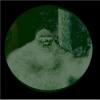I'll preface this by saying that I am a licensed professional chemical engineer. I'm also a West Point graduate and served on the faculty at West Point for four years, coordinating eighteen faculty in the instruction of a 900 cadet course. I'm happy to document this for the moderators, but I'm pretty sure they've already looked into my background in the past. I'm not an anthropologist, but I am an applied scientist with a book published (through Whitman) and a patent awarded in the U.S. this year (both unrelated to anthropology or bigfoot). I'm going to contrast here the attitude of a scientist who has encountered a bigfoot with that of a scientist who has not.
If you've had a face-to-face encounter with a bigfoot, you've established a boundary condition for yourself. You understand that they do, in fact, exist. Whether you can demonstrate it to others or not, you understand that they're no longer a possibility, a maybe - that they are a fact (not a belief, a fact). After that, for yourself, it is no longer a question of "do they or don't they", but a lot of questions that start with "how".
For a person like myself, since I know them to exist and to be natural creatures like ourselves that do, in general, the same things we do, I understand that they have logical reasons for their behavior as a species and leave behind evidence. I never dismiss the possibility of a hoax, because there are certainly huxsters and idiots who create hype and hoaxes, but my attitude upon approaching data or evidence is different than that of a scientist who has not had first-hand experience.
When I look at data or evidence, the first question I have is: "Is this evidence real or manufactured?" I've got a lot of filters I use personally and I safeside my assessment. I mentally discard anything even slightly dodgy, probably dismissing some bonafide, but indeterminate, data. But you end up with a few nuggets. If information that I've previously considered indeterminate keeps showing up, I begin to look at it more seriously. For example, in spite of my several encounters, I've never heard one speak (only calls, howls, woodknocks, etc. - a collectively sophisticated array of signals). But I've now heard enough from people I have learned to respect that I believe (not know in this case) bigfoot do have their own language and may be able to understand some of ours. I've also come to assign a high probability to the ultrasound theory, and it does, in fact explain an effect I witnessed in one of my friends who was frozen in apparent shock during one of my encounters (he was within five feet of it, I was further away).
My point is that I can actually look at data and evidence without the burden of the primary doubt - "do they or don't they exist?".
Any analysis that a guy like Disotell performs, however, is burdened by that unanswered question. To objectively analyze evidence, he has to suspend either belief or disbelief. This is hard to do. Disotell has a track record of skepticism, and that's fine, but his beliefs are going to color his conclusions. It is also clear that he is a person who actively manages his public reputation, and his statements may be self-serving to the extent that they further what he wants people to think of him, and at this stage this likely skews things towards dismissiveness. Watch for a 180 when proof finally breaks, in whatever form that may take.
From a personal perspective as an applied scientist who has literally faced the primary fact, though, I can say this.
Since they exist (my fact, your belief or disbelief), there is evidence.
Since they are biological creatures, they have DNA.
Since some of the evidence is biological, it contains DNA.
Since DNA exists, and is available in some of the evidence, an analysis can be performed.
With proper procedure and safeguards, the analysis can be conclusive and defensible.
So I conclude that someone, somewhere, someday can provide a DNA analysis that proves bigfoot exists and may answer several other questions regarding origin and nature.
I suspect, given all of the positioning by people who have conducted research and collected evidence over the years, some of whom claim to have seen the paper, that there is, in fact, an actual paper that contains information that they believe will constitute proof. If it doesn't exist, then some of the best lay researchers, who safeguard against hoaxes for self-protection, have been hoaxed.
I could perform a similar analysis regarding MK's credibility, but I don't see a need to do so. I'll simply attribute the hang-ups in getting the paper out to inexperience. I'm sure she would agree that if she knew earlier what she knows now, she would have taken different steps along the way and would be further along. That said, I don't doubt that the raw data exists and that the DNA has been tested extensively.
Since I conclude that the data exists and is confirmed, that leaves only the putative chain of custody for the samples and the interpretation of the data as potential problem areas.
I figure that MK a Journal will eventually work through these together and we will see a publication.


